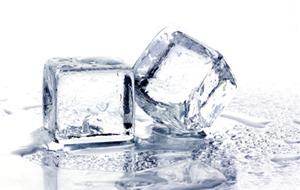| Complexity level: | 4 |
| Project cost ($): | 10 |
| Time required: | 1 hour to prepare, 5 hours for observation |
| Material availability: | Easily found |
| Safety concerns: | Basic safety requirements |
Hypothesis
Ice stored in a container covered with aluminum foil will melt at a slower rate.
Overview
Keeping ice from melting
Is there an alternative to the foam cooler box?. There will be instances when we are out on a picnic or on an outdoor trip and we need something to keep our ice from melting - and what if we can't get hold of a cooler box? Although ice cannot be prevented from melting , there are ways to keep it frozen for just a little longer. Thermally insulated cooler boxes are pretty good for this. These containers prevent the transfer of heat from the inside of the container to the exterior and vice-versa. Ice buckets and Styrofoam boxes take advantage of this principle to keep ice from melting. Common thermal insulators include nylon lined fabrics, styrofoam and hard plastics.
But perhaps . keeping ice in light-colored containers or reflective containers might also help keep it frozen. Theoretically, lighter colors and reflective surfaces absorb less radiation from the sun. This should mean that a smaller quantity of heat would be and therefore the ice should melt more gradually. As an alternative to reflective containers, perhaps the ice can be covered with aluminum foil to obtain similar results.
Scientific Terms
Materials
The materials required for this science fair project:
- 3 conical flasks
- 3 corks
- A roll of aluminum foil
- A roll of kitchen towel paper
- A bag of ice
- 3 white towels
- A digital weighing scale
- 1 clock
Procedure
1. For this science fair project, the independent variable is the material used to cover the conical flask i.e. kitchen paper towels and aluminum foil, and finally, an uncovered flask. The dependent variable is the time taken for the ice to melt. This is determined by inspecting the ice inside the flask to ascertain if it has melted. The constants (control variables) are the size of the conical flask, the amount/weight of ice cubes placed in each flask and the room temperature.
2. Using a digital weighing scale, 150grams of ice cubes is used. Equal amounts of ice are placed in each of the 3 conical flasks. The 1st conical flask is uncovered. The 2nd conical flask is wrapped in 3 layers of kitchen towels and the 3rd conical flask is wrapped with a layer of aluminum foil. The bottom of the 2nd and 3rd conical flasks are left uncovered.
3. 3 white towels are folded and placed on the table, in a cool spot, away from windows and any other heat sources. Also ensure that there is no wind/draft blowing against the flasks, as this might affect the results of our experiment. The 3 conical flasks are placed on top of each towel. This is done to prevent the conduction of heat from the table to the conical flasks.
4. The 3 conical flasks are inspected every 30 minutes to see if all the ice has melted. A visual inspection should be done. Record your findings in the table below.
Results
It is observed that the ice in the conical flask covered with the aluminum foil stayed frozen the longest. The ice in this flask stayed frozen (at least some of it), for a significantly longer period of time than the other flasks.
| Thermal insulation | Time taken or the ice to melt | |||||
| Start | 0.5 hour | 1.0 hour | 1.5 hours | 2.0 hours | 2.5 hours | |
| None | Y | Y | X | X | X | X |
| Kitchen towels | Y | Y | Y | X | X | X |
| Aluminum foil | Y | Y | Y | Y | Y | X |
Y - ice not melted, X – ice has melted
Conclusion
The hypothesis that ice in a container covered with aluminum foil will melt at a slower rate is proven to be correct.
There are many ways to prevent ice from melting during an outdoor trip or event. Apart from placing ice cubes in special ice barrels or insulated containers, they should also be kept in a cool and well- shaded area to prevent the containers from warming up. By keeping the ice away from hot food and other sources of heat radiation, the ice will also melt at a slower rate. Using larger ice cubes or ice blocks will also help to keep food and drinks chilled for a longer period of time.
Also consider
Try to repeat this science fair project using different colored containers.
Compare the rate of melting when ice is placed in containers insulated with styrofoam, bubble pack, and fabric. Which of these offers the best insulation? How about a vacuum flask?
References
How to prevent ice from melting - http://lifestyle.iloveindia.com/lounge/how-to-prevent-ice-from-melting-6207.html
Color matters - http://www.colormatters.com/colorheat.html

